The Ridekick PT (Power Trailer) will turn almost any regular bike into an electric bike by connecting to the rear axle and pushing the rider forward. It’s cheaper than most fully-built electric bikes and is much easier to transport because it can be completely disconnected. The battery inside is also removable which makes lifting the unit easier. With this trailer you can store your books, work stuff, groceries and and many other items while keeping them protected from the elements and prying eyes. It’s easy to fall in love with the idea of the Ridekick and indeed, it performs very well with its powerful 500 Watt motor and axle push system, but it’s got several drawbacks worth considering before jumping onboard.
The first thing most people wonder when they see a Ridekick for the first time is “does it actually work?”. It seems counter intuitive to be pushed by an electric motor, especially by a smallish looking trailer connected with a spring bound hitch. I wondered this same thing the first time I saw one and was concerned about the possibility of jack-knifing, having the trailer slide sideways and push me over, when going up hills or taking sharp turns. In reality, the Ridekick works very well and even pushed me up medium sized hills without issue.
One drawback of the propulsion design on the RideKick is that it only powers the left wheel which is mounted directly, via chain, to the 500 Watt motor in the undercarriage of the trailer. This means that over time the left tire will wear faster than the right one and it also creates an awkward storage compartment floor area inside. This is necessary in order to achieve the small form factor and aerodynamic qualities of the Ridekick but it means you might have to replace a tire down the line, store your stuff at an angle and eventually rotate the tires. That brings us to another hurdle, it’s very hard to remove the wheels on the Ridekick. Instead of one long axle, this unit has two separate ones and if it gets bent you will simply have to deal with a wobbly wheel on one side… which isn’t terrible but can be annoying if you just spent $700. None of these drawbacks are deal killers but they should help to paint a picture of how the Ridekick actually works and some of its vulnerabilities.
The versatility of the Ridekick is awesome in the sense that you can fully disconnect it and be back to your regular old bike in minutes. Even with it connected, bike riding feels more nimble and banking turns is less scary than on full sized ebikes with batteries mounted up high. The RideKick takes advantage of all the money you poured into a fancy touring bike, full suspension mountain bike, recumbent bike or carbon fiber road bike and works with nearly everything except for super high-end bikes with through axles that are too wide to accommodate the hitch mount.
When hooking up the RideKick for the first time you have to run a wire along the length of the bike frame and up to the handle bars where the throttle will strap on. There are little velcro strips that hold the wire and mount the trigger throttle in place and while they work well enough, they do look tackier than a fully integrated wired or wireless solution. The trigger throttle itself works well and offers precise variable speed control. I like the fact that it mounts using simple velcro straps because that makes it much easier to setup with drop handle bars.
One of the most annoying parts of the Ridekick is also its biggest strength, it can carry stuff! On the one hand it’s utilitarian, waterproof, aerodynamic, secure and spacious. On the other it’s noisy, bouncy, prone to cracking (if you over extend the lid when opening), easy to trip over and get in the way at bike racks. Because it is light weight and made in part of plastic, the Ridekick just rattles a lot and that makes it louder than most electric bikes I’ve used. The motor is also not the quietest. If you’ve ever heard a skateboarder cruising down the sidewalk making those clack-clack, clack-clack noises, you’ll have some idea for what the Ridekick is like when going over larger cracks and bumps in the road. It’s not nearly as frequent as a skateboard but it’s the same concept and it feels tackier and cheaper than many full electric bikes with shocks and large soft tires.
The tires on the Ridekick are pretty solid and less prone to flats than most other electric bikes because they are so thick. The unit itself only weighs ~45 pounds so that’s less weight bearing down on the tires when going over hazardous objects. I’ve heard horror stories about normal electric bikes getting flats and having to be walked or carried home. The Ridekick by comparison would run pretty well even if the tire did get a flat and the wheel frame wouldn’t get damaged as easily. It’s also so easy to disconnect and transport in a car that you could easily get a friend to just pick it up or lock it to a pole and come back later. The metal tubing that makes up the hitch for the Ridekick has a built in welded loop that makes locking easy.
The low price point and versatility of the Ridekick makes it an enticing product. In my opinion it’s more of a tool than a mode of transportation like higher end fully integrated electric bikes but that’s okay. I vary between riding an electric and regular bike to work each day and given the awkwardness and noise of the Ridekick I’ve considered owning one as a separate option for grocery stopping but couldn’t justify the price when I could simply put panniers or a Burley trailer on my electric bike. Note that RideKick is working on a full sized kids trailer with motor integration!
If you’re into recumbent bikes the Ridekick may be one of your only options to go electric and in that case it’s a great option for everyday use! This trailer is built tough, does well in wet environments and offers something fun and unique. The company that makes these is also very fun and authentic. They assemble the units at a factory in Colorado and field any support requests very quickly and with a lot of positivity.
Pros:
- cheaper than most full electric bikes, inexpensive battery replacements
- very easy to transport and store, can be tipped onto its back for vertical storage
- built tough, holds up well in wet environments
- great storage potential, adjustable combination lock
- upgradable firmware, great charge/discharge control to support battery life and performance
- built in USB port for charging a phone or other device
- does not get flat tires as often as full ebikes, tough tires, less weight bearing down
- quick connect/disconnect hitch is efficient, strong and has built in locking loop
- wonderful company with great support and commitment to product
- trigger throttle works well and can mount on any bike
- low weight distribution creates a nimble riding experience that’s more stable than a heavy full electric bike
- can mount to any bike including recumbent, trikes or scooters
Cons:
- limited color selection, wish it came in simpler better-matching colors
- somewhat tacky looking wires and throttle solution
- very noisy and bouncy on bumps, rattling plastic sound
- relatively loud brushed motor with chain connection
- gets in the way at bike racks
- hard to remove wheels, left wheel drives trailer and wears faster, hard to change tires
- harder to go up curbs and fit through narrow gates, obstacles and corners
Resources:
- Official Site: http://www.ridekick.com/
- More Pictures: https://goo.gl/photos/vw1ehsdkGo8urfqY7
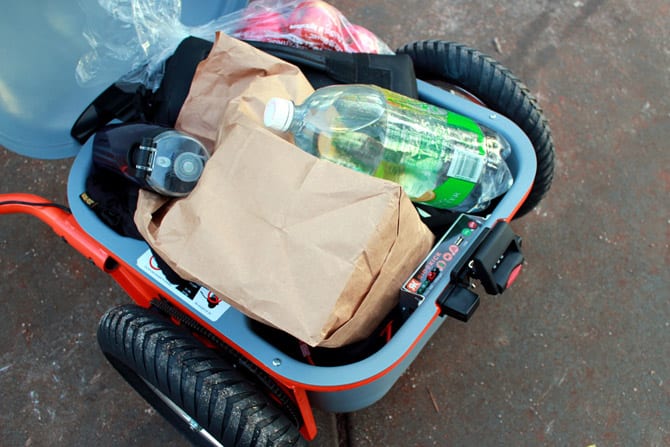
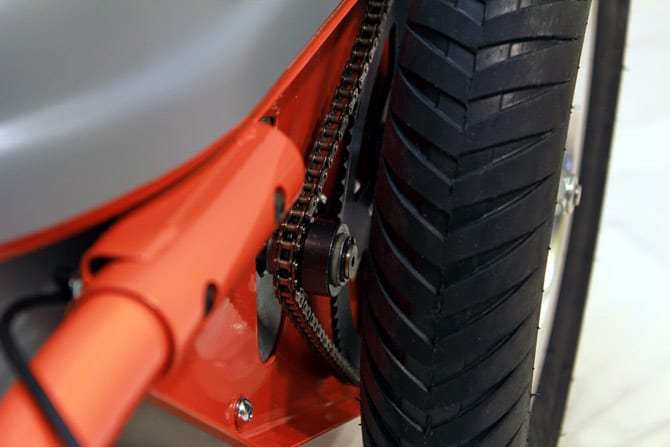
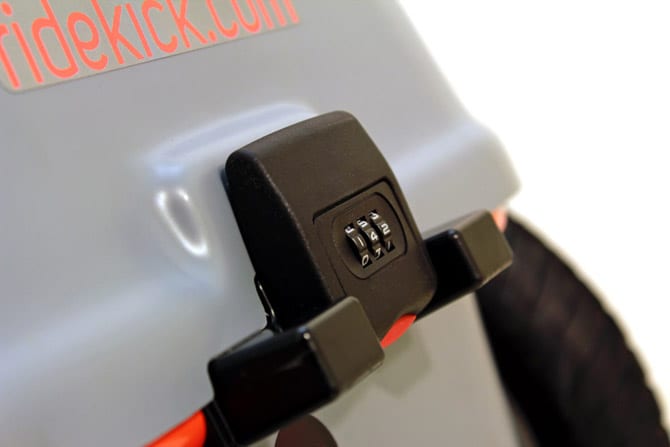
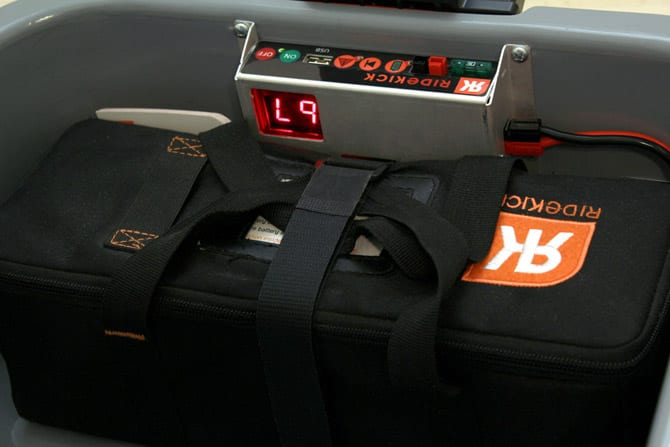
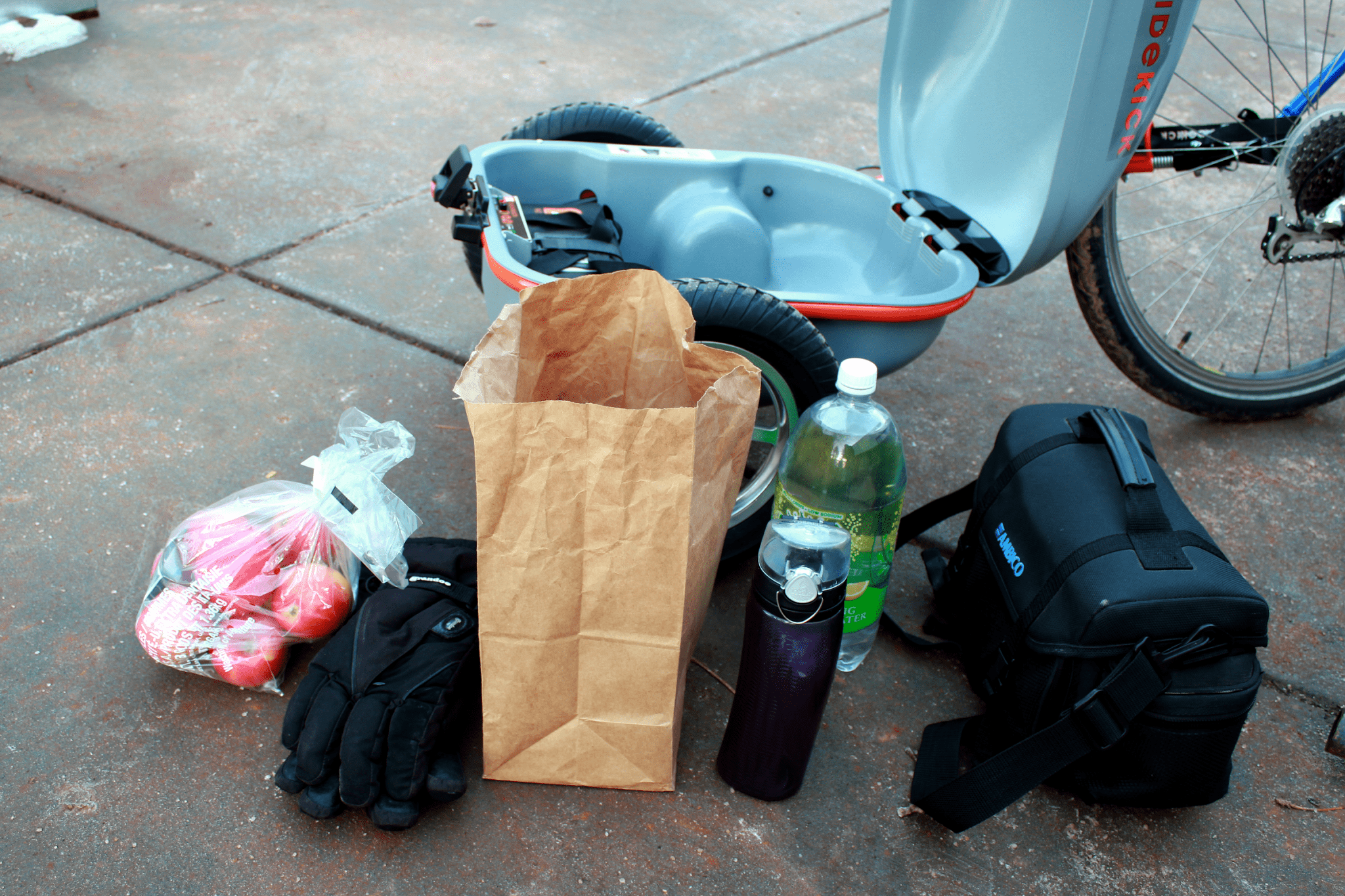
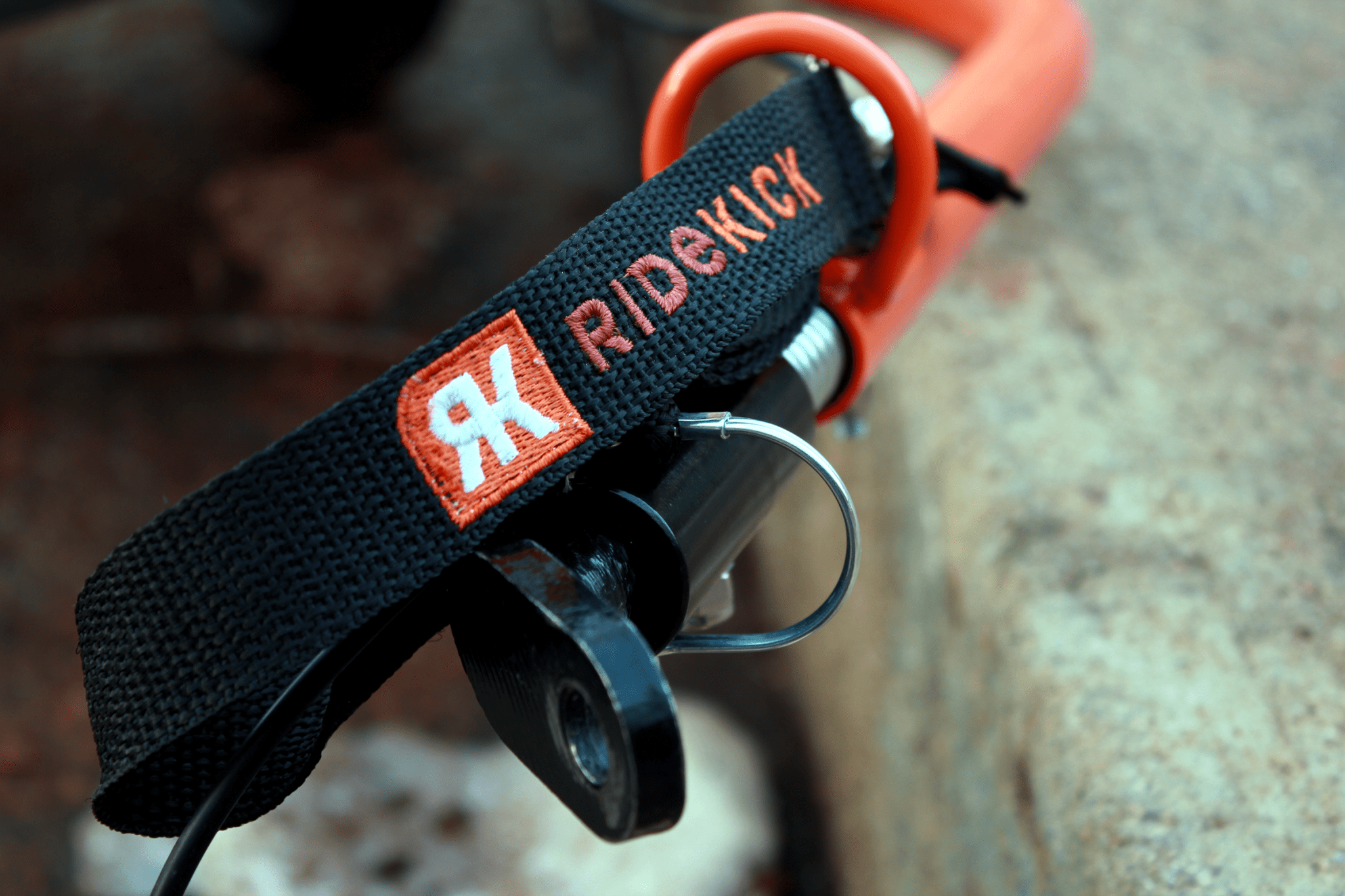

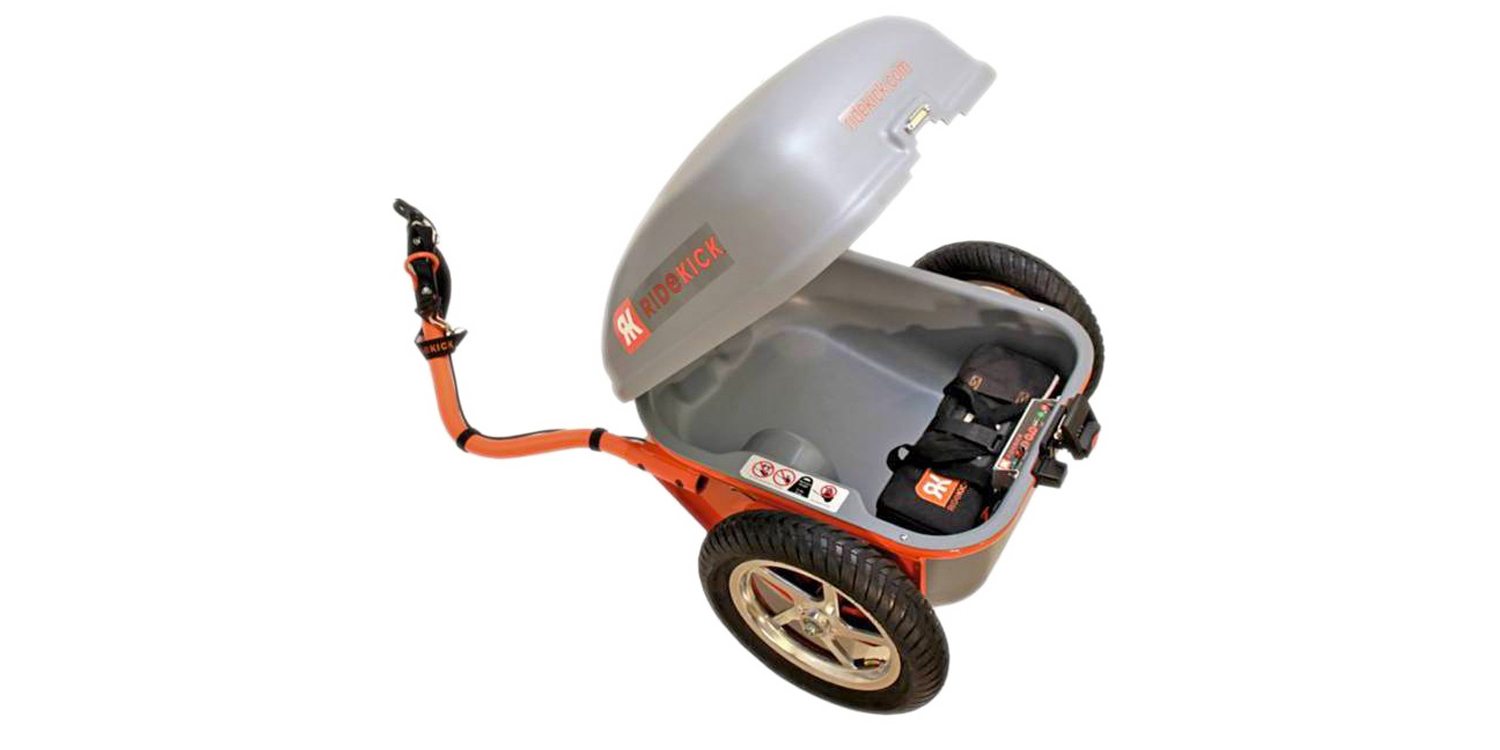

mike says
Recumbents use 20″ and 26″ wheels for the most part and are not harder to convert than any other bike, with the possible exception of needing longer wires for some. I’ve seen a lot of recumbent conversions (especially trikes) and there are some companies offering electric options from the factory. It’s just in the US recumbents are hard to find that are not just looking like crappy old 10 speeds chopped and welded. In any case there is a review on Endless Sphere about a defective Ride Kick Controller. It was simply manufactured wrong (Bad Heat Sink). Ridekick chose to ship these units and wait until the customers complained (Bad choice). Also if you look closely at the parts they are just scooter parts. The Ridekick design is interesting but there is a very large markup for scooter parts. The pricing on Lithium is ridiculous as are the claims of longevity. With a 6 month warranty on the battery you would only get 180 charges if you used it every day. Many better choices for batteries from other vendors. Lithim would work just fine. If you want more weight put in a gallon of water and dump it when the battery rant out so you don’t have to drag it along. Nice to see a review that isn’t just a glossy PR spill. I think the Ridekick is a good idea, but in need of a lot of improvement.
Lizzie says
I have owned a Ridekick for some time and really really like it overall. What I have learned from months using the trailer are: Despite what the reviewer above suggests, the trailer is not easy to ride with a flat and replacing/repairing the tube on the street is no fun! The tires are bulky and are harder to remove/replace than on a regular bike wheel. As a result I always carry two tubes of co2 to get me to my destination even if I have a flat (a full on blow out would mean leaving the trailer locked to a post!) I did have a bad throttle cable which RKI quickly replaced. As an early adopter of the trailer, I was not surprised by the issue and it was resolved quickly and satisfactorily by RKI. They provide excellent customer service.
Also, I did flip the trailer over once which pulled my bike violently to the side. The lesson learned was not to try to ride the trailer over big obstacles! But I suppose this is true of any trailer. The trailer does rattle if it is not latched properly, but overall I do not find the trailer to be noisy. I do think the trailer is a total blast to ride, and I do not object to “scooter parts” being used. I have priced some of those parts and when you add them up, plus consider the labor it takes to build, store, and sell the trailers, I think they are fairly priced! In fact, because parts can be bought online, some degree of DIY’ing can be done. For example, rather than buying a second battery pack from RKI (they were not available at first) I simply bought two extra batteries online and connected them in series – so I can double my range if I want. If you don’t want to go through RKI, you might also buy an extra charger online to keep at work, or a spare tire, whatever.
Kelley Butler says
I’ve had my ridekick for over a year now. Like the other reviewer, I flipped it once but entirely my fault for trying to jump a curb at an odd angle. I do not find it any louder than other electric bikes and I can fit an amazing amount of groceries in it. Plus I never use it without someone asking me about it, I hope Ridekick begins shipping again soon.
Court Rye says
Thanks for the testimonial Kelley! I hope they are able to stay in business as well. The first gen RideKick has been awesome but I think they were struggling with quality on some of the frames and parts coming from overseas. They were trying to do a lot of the work in the USA and even sourcing parts domestically which is pretty neat. Here’s a video tour of their original facility and one of their newer space which was working on the child trailer design.
Paul says
“I simply bought two extra batteries online and connected them in series – so I can double my range if I want.” I assume you meant that you hooked two 12V batteries in series since the RideKick is a 24V system.
Jay says
Here’s a question to the owners. Have you ever ridden the Ride Kick to work? How did you secure it? Did you lock it to a pole?